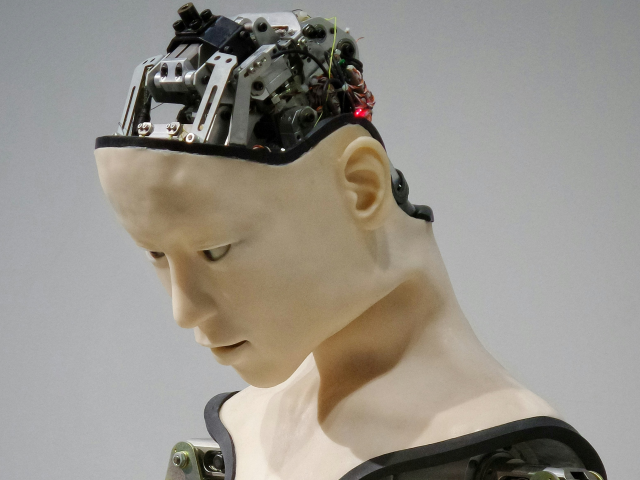The Gist
- Strategic design choices. Employ strategic design and technology to navigate the uncanny valley in marketing for enhanced customer engagement.
- Ethical marketing standards. Uphold ethical standards in AI and digital content to maintain trust and transparency in consumer interactions.
- Emotional consistency importance. Ensure emotional consistency in AI interactions to foster user comfort and enhance brand loyalty.
The term uncanny valley refers to the creepy or unsettling feeling people often experience when robotic and digital representations look and act almost, but not exactly, like human beings. As technology and AI continue to advance, pushing the boundaries of realism, it becomes crucial to understand where this phenomenon can negatively impact marketing, advertising and the customer experience. This article examines the threshold where cutting-edge realism in robotics and AI goes too far, provoking discomfort rather than engagement, and examines the implications for marketers, advertisers and customer experience professionals.

Understanding the Uncanny Valley
The concept of the "uncanny valley" refers to a phenomenon where humanoid objects that closely resemble humans provoke eerie or unsettling feelings among human observers. This phenomenon becomes particularly relevant in modern technology as advancements in robotics and AI increasingly allow for the creation of figures that are almost indistinguishable from real humans, as can be seen in the human-like robot named Alex, pictured above.
The uncanny valley theory posits that as these representations become more lifelike, they reach a point where the minor imperfections or deviations become profoundly disturbing, leading to discomfort rather than affinity. This is particularly significant in fields such as robotics, virtual reality, and artificial intelligence, where the design of human-like agents must consider psychological impacts on human users. In addition, the prevalent consumer distrust of AI adds complexity for brands using AI-generated content in marketing, advertising, and customer interactions, highlighting the need for careful consideration of psychological effects in AI design and transparency in disclosure.
Related Article: Generative AI in Marketing: Boost or Bust for Your Department?
The History and Origins of the Uncanny Valley Concept
The term "uncanny valley" was first coined by Japanese roboticist Masahiro Mori in 1970. It describes a phenomenon in which humanoid objects that appear almost, but not exactly, like real human beings elicit feelings of eeriness and discomfort among some observers. The theory posits that as the appearance of a humanoid becomes more realistic, it reaches a point where the slight imperfections become strangely unsettling, causing a dip in human comfort levels — hence the term "valley" in the graph of comfort level against human likeness.
The theoretical background of the uncanny valley is rooted in both psychological and evolutionary perspectives. Psychologically, this discomfort is often attributed to the humanoid falling into a zone where it is close enough to human to be recognizable but still distant enough to be alien, triggering a sense of unease or even revulsion. From an evolutionary standpoint, these feelings may have developed as instinctual reactions to prevent early humans from engaging with something that looks human but is not, potentially serving as a mechanism to avoid pathogens or social entities that do not appear normal or healthy.
The uncanny valley extends beyond humanoid robots, affecting perceptions of any unnatural depiction of living beings, including AI-generated aliens, as shown below, and animals, as demonstrated in the examples we will explore.

Uncanny Valley Effects in Marketing and Advertising
The uncanny valley phenomenon has significant implications for marketing and advertising, especially as brands increasingly use advanced digital representations and AI technologies. This is particularly relevant in areas involving the creation of digital avatars, virtual assistants, and AI-generated images and video in advertising and marketing. As these representations become more lifelike, marketers must be wary of crossing into the uncanny valley, where the subtle imperfections of these nearly human figures could inadvertently repel consumers rather than engage them. This is crucial in campaigns that rely heavily on the relatability and appeal of characters, such as in video games, virtual reality shopping experiences and interactive marketing.
Tony Fernandes, CEO and CAIO of UserExperience.AI at UEGroup, a full-service user experience agency, told CMSWire that although he's not a psychologist, he believes that people are uniquely sensitive to things "not looking right" because it is associated with somebody trying to fool, trap, or harm. "This issue of being fooled extends into well-executed realism. If a brand does not disclose that the experience is artificial, people will eventually find out and feel fooled," said Fernandes. "Leaving people with the feeling that you tried to fool them is never a positive brand attribute. In addressing successful customer experiences, brands must decide which side of the valley they want to live on and stay there.” Fernandes said that brands such as MailChimp and Dropbox have firmly put themselves on the illustration side of the valley, while brands like Revlon are clearly on the realistic side of the valley. “Pick a side and stay there. If you go toward realism, be transparent about it."
The customer experience can be deeply affected by the uncanny valley, especially in the ways consumers perceive and interact with the brand. If potential customers feel discomfort from a virtual assistant or AI character that is too lifelike, it can create negative associations with the brand, reducing the effectiveness of marketing efforts and damaging brand loyalty. On the other hand, successfully navigating the uncanny valley can enhance engagement, making digital interactions more pleasant and memorable, and positioning a brand as a cutting-edge leader in using new technologies.
Understanding the nuances of the uncanny valley enables marketers to better strategize around the deployment of realistic digital entities, ensuring that these innovations attract rather than alienate their intended audiences.
Related Article: The Unforeseen Consequences of Relying on AI in Marketing Strategies
Case Studies: Success and Failures in the Uncanny Valley
Some brand strategies successfully enhance relatability without discomfort, demonstrating effective navigation of the uncanny valley. Conversely, other examples reveal how technological missteps can inadvertently repel audiences, underscoring the complex challenges and significant impact these decisions have on viewer perception and engagement in animation, robotics and digital media.
Disney has consistently managed to navigate the uncanny valley effectively with its animated characters. By creating figures that are lifelike yet stylized enough to avoid eeriness, Disney enhances relatability without discomfort. For instance, the characters in "Frozen" exhibit human-like emotions and movements but have exaggerated features that clearly distinguish them from real humans. This approach has enabled Disney to connect deeply with audiences, making its films beloved across generations.
Sony's Aibo, a robotic pet designed to mimic the behavior and appearance of a small dog, initially faced mixed reactions due to its uncanny resemblance to living animals coupled with robotic mannerisms. While some users felt an emotional attachment, others experienced unease due to Aibo's lifelike yet slightly off movements and interactions, demonstrating how even non-human designs can evoke the uncanny valley effect.
In a more successful robotic example, Toshiba introduced ChihiraAico, an android that sings and communicates with near-human appearance, as shown below, at events such as trade shows. Toshiba designers carefully balanced her features to be familiar yet noticeably artificial, which helped avoid the deep unease typically associated with the uncanny valley, making her a hit at demonstrations.

ChihiraAico was still considered to be well within the uncanny valley, as this article from TheRobotReport described her as The Creepiest Robot of CES.
Films such as "Polar Express" and "Beowulf" used early motion capture technology to create human characters and were criticized for how these characters looked and moved. The characters' eyes and facial expressions often felt dead or doll-like, which disturbed viewers and detracted from the overall cinematic experience. This highlighted the challenges of using motion capture to create realistic human characters without inducing discomfort.
These case studies highlight the complexity of using human-like images and robotics in marketing and media. As technology enables more realistic creations, it's essential for designers and marketers to carefully consider the uncanny valley's potential to alienate audiences. Careful consideration of character design and movement can make the difference between a character that is endearing and one that is disconcerting.
Overcoming the Challenges of the Uncanny Valley
In the quest to overcome the uncanny valley in marketing and advertising, professionals are employing a blend of strategic design choices and leveraging technological advancements. A popular strategy involves opting for stylization over realism; by creating characters with exaggerated or distinctly non-human features, designers can clearly distinguish these figures from real humans, reducing the eerie sensations associated with hyper-realism. Complementing this approach, developers are also focusing on enhancing behavioral realism. Advances in motion capture technologies allow for smoother and more lifelike movements in animated characters and robots, which helps align physical realism with behavioral expectations, reducing the mechanical or disjointed motions that often trigger unease.
Avoiding the uncanny valley when using AI-generated images and videos should also be a priority for brands. “Some companies are looking at using realistic imagery to save money but they must consider this: Establishing trust is at the heart of every type of relationship including relationships between customers and brands,” said Fernandes. “Why would a brand want to risk trust that has potentially taken years to build for the sake of saving money on an ad, communication with the customer, or in-person experience?” Fernandes suggested that brands that want great customer experiences have to keep their eyes on the prize: establish trust, value and loyalty. “They must ask if what they are doing with AI or robotics is the best way to move that agenda forward.”
Further mitigating the uncanny valley effect, emotional consistency in the expressions and interactions of humanoid characters ensures that their emotional outputs are appropriate and contextually relevant, creating a sense of familiarity and trust among users. Additionally, the strategy of incremental exposure allows audiences to gradually acclimate to more realistic designs, easing initial discomfort and building acceptance over time.
Chris Todd, principal of marketing operations at CallTrackingMetrics, a calls, chats, forms, and texts tracking platform provider, told CMSWire that AI that makes people uncomfortable is going to pop up when a team starts using AI for the wrong reasons. "If you’re using AI solely to make your job easier, the uncanny valley is right around the corner. Focus on the customer experience and you can use AI in a way that lowers the risk of being creepy—and hopefully still makes your job easier," said Todd, who added that it can’t be about tricking people into thinking AI isn’t involved.
"Lean into users' growing acceptance of AI and be open about it. Deploying a chatbot? Use a non-human name and include links to where the AI is sourcing its information.” Todd suggested that brands use feedback prompts to make the AI more effective and continually optimize the path to help, whether the help comes directly from AI content or through more efficient routing to a human resource. “As we continue refining AI, we must prioritize achieving desired outcomes over mere replication of human responses."
On the technological front, improvements in AI emotional intelligence are crucial. As AI becomes better at reading and responding to human emotions in real-time, interactions with digital agents become more natural and less unsettling. Real-time rendering improvements also play a significant role; more sophisticated graphics rendering technologies that allow lifelike lighting, textures, and shadows enhance the realism of digital figures without crossing into discomfort. Finally, implementing feedback loops that collect and analyze user responses to these designs allows for ongoing adjustments, ensuring that digital agents continuously evolve in ways that are aligned with user comfort and preferences. Together, these strategies and technologies offer a comprehensive approach to reducing the impact of the uncanny valley, enhancing user engagement with digital characters in marketing and consumer products.
Ethical Considerations in Navigating the Uncanny Valley
The production of ultra-realistic digital content involves replicating human likenesses with such precision that it can be difficult to discern real from synthetic. This capability introduces concerns about consent, especially when real people's likenesses are used without their explicit permission, potentially leading to misuse or misrepresentation. In addition, the authenticity of communication is at stake. When consumers cannot easily distinguish between real human interactions and those generated by AI, it challenges the trust and transparency that form the foundation of ethical marketing.
The ethical implications extend into the potential social impacts of these technologies. As digital representations become increasingly lifelike, they may influence societal standards of beauty, behavior, and ethics, potentially reinforcing unrealistic expectations and stereotypes. Additionally, the emotional manipulation capabilities of these technologies — able to evoke responses from audiences based on engineered interactions — raise concerns about the psychological effects and the potential for exploitation.
These ethical challenges require a thoughtful consideration of how such technologies are developed and employed. Marketers and technologists must work together to establish guidelines that protect individual privacy, ensure consent, and maintain the authenticity of human interactions, building an ethical framework that respects both individuals and the broader societal impact. This approach not only addresses the immediate ethical concerns but also anticipates the long-term implications of blurring the lines between reality and simulation in digital media.
The Future of Human-Like AI
The uncanny valley phenomenon poses a significant challenge for marketers and advertisers as advances in technology enable the creation of increasingly lifelike digital representations. Careful consideration of character design, behavioral realism, and emotional consistency is crucial to navigating the uncanny valley and ensuring that digital agents engage rather than unsettle consumers. By striking the right balance between realism and stylization, and upholding ethical principles, brands can leverage the power of advanced technologies to captivate their audiences without falling into the uncanny valley.
